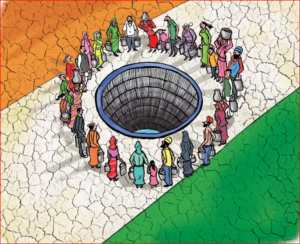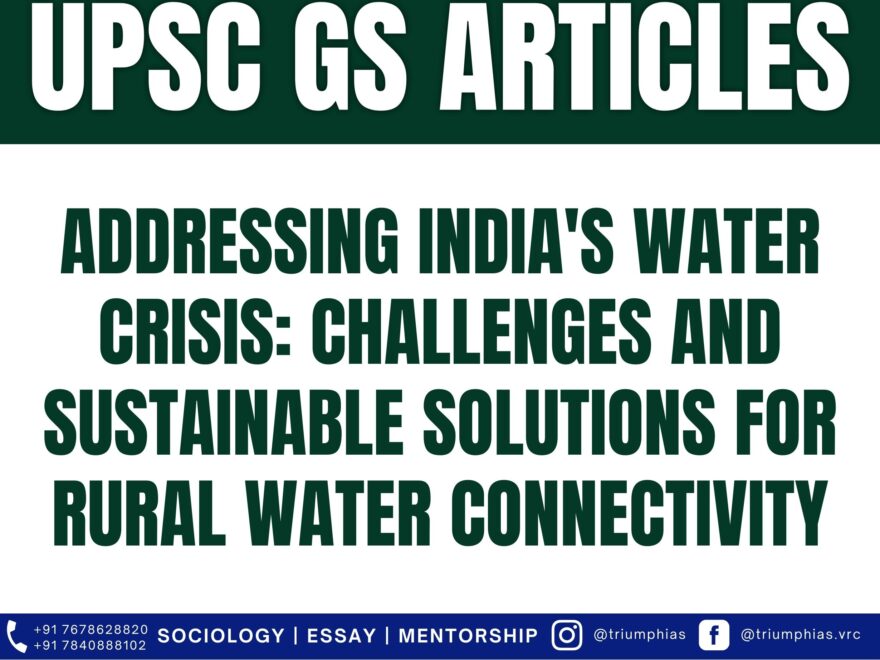India’s Water Crisis & Challenges
(Relevant for General Studies Paper Prelims/Mains)

Access to clean and safe tap water is an essential requirement for every household to ensure basic health and hygiene. However, a significant portion of the rural population in India still lacks this vital amenity.
Out of the approximately 250 million households in India, rural areas account for around 195 million households. Unfortunately, the provision of a tap water connection capable of delivering 55 liters of clean drinking water per person per day (as envisioned under the Har Ghar Jal Scheme) is uncommon in rural regions.
The limited access to potable tap water has various implications for rural communities. It hinders daily activities such as cooking, cleaning, and personal hygiene. In many cases, communities have to depend on alternative sources such as wells, hand pumps, or natural water sources, which may not always meet the required cleanliness and safety standards.
It is crucial to effectively implement the “Har Ghar Jal Mission” in order to address the challenges associated with rural water connectivity in India.
Status of Water Management in India
- India holds the record for the highest groundwater extraction globally, surpassing the combined extraction of the second and third largest extractors, namely China and the United States. However, a mere 8% of the extracted groundwater in India is utilized for drinking purposes, while a significant 80% is allocated for irrigation. The remaining 12% is allocated for industrial uses.
- The Composite Water Management Index, developed by NITI Aayog, has raised concerns about the water crisis in India, indicating that over 600 million people are currently facing severe water shortages. Furthermore, projections suggest that by 2030, the country’s water demand will be twice the available supply.
Challenges Regarding Water Management in India
- Cities are experiencing rapid expansion due to urbanization, resulting in an increased demand for water driven by the influx of migrants from rural areas. As a consequence, water is being transferred from rural reservoirs to urban regions to meet the growing deficit in per capita water consumption.
- Many rivers in India, particularly those flowing through multiple states, have become a subject of disputes among states regarding water sharing, utilization, distribution, and control.
- In an environment already facing high water stress, the inefficient utilization of wastewater has prevented India from maximizing the economic potential of its water resources. This is particularly evident in cities, where a substantial amount of water exists in the form of greywater.
- Water is essential for the growth of crops and livestock, and it plays a crucial role in agricultural irrigation as well as domestic consumption. However, with rapidly declining groundwater levels and ineffective management of river water, the risk of food insecurity is becoming more prominent.
- Water bodies are subjected to a significant amount of domestic, industrial, and mining waste discharge, leading to potential waterborne illnesses. Additionally, water pollution can result in eutrophication, causing detrimental effects on aquatic ecosystems.
What need to be done
- A proper mechanism and integrated projects that focus on rural-urban collaboration are required to address the challenges related to groundwater recharge and rainwater harvesting at the household level. It is crucial to implement strategies such as the conjunctive use of surface water and groundwater, as well as the regulation of water reservoirs.
- Furthermore, improving water infrastructure, including groundwater wells, dams, storage tanks, pipelines, and other related systems, is essential. Such improvements would not only help reduce wastage of clean water but also alleviate the daily struggle faced by individuals in search of clean water.
- In the realm of agriculture, the adoption of smart techniques is necessary. Drip irrigation, for instance, is a powerful technology that can significantly decrease water consumption by 20-40%, while simultaneously increasing crop yield by 20-50% compared to traditional furrow (flood) irrigation methods.
- Additionally, promoting the cultivation of crops that require less water, such as pulses, millets, and oilseeds, in water-stressed regions should be encouraged. This approach will help optimize water usage and mitigate the strain on water resources.
Efforts should be directed towards enhancing water governance and establishing a more robust data management system to accurately monitor the condition of water bodies at various levels, including regional, state, and national. It is crucial to emphasize the creation of water conservation zones as well.
To master these intricacies and fare well in the Sociology Optional Syllabus, aspiring sociologists might benefit from guidance by the Best Sociology Optional Teacher and participation in the Best Sociology Optional Coaching. These avenues provide comprehensive assistance, ensuring a solid understanding of sociology’s diverse methodologies and techniques.
Water Management, Rural India, Har Ghar Jal Mission, Groundwater Extraction, Water Infrastructure, Drip Irrigation, Water Conservation, Water Governance, India Water Crisis, Sustainable Solutions, Urbanization, Water Demand, Best Sociology Optional Teacher, Best Sociology Optional Coaching, Sociology Optional Syllabus.
Follow us :
🔎 https://www.instagram.com/triumphias
🔎https://www.youtube.com/c/TriumphIAS
https://t.me/VikashRanjanSociology
Find More Blogs
|
Scope of the subject and comparison with other social sciences |
|||
|
|
|
|
Modernity and social changes in Europe |

